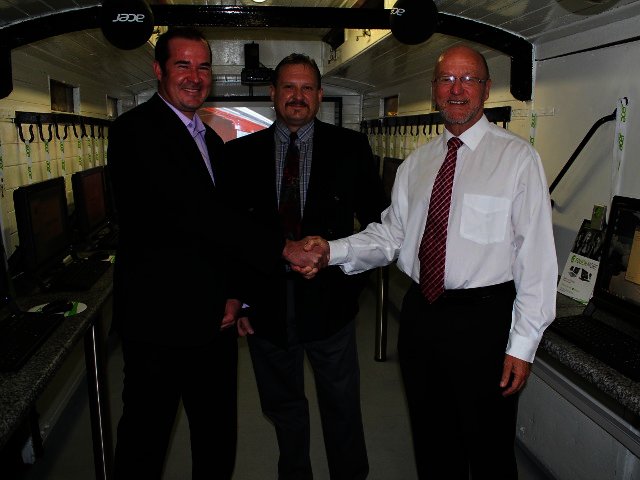Acer Africa, together with partners Department of Science and Technology (DST) and the National Research Foundation (NRF) are set to become a part of the only Space Geodesy and Geophysics Observatory (SGGO) in the southern hemisphere which was officially launched in the quaint Central Karoo District of Matjiesfontein in the Western Cape, South Africa.
The Matjiesfontein site has been fully equipped with top of the line Acer products and internet access which will enable students and scientists conduct their research and facilitate classes on subjects like mapping, geosciences, engineering geology, geodesy, space geodesy and mineral exploration amongst others.
Together with the Matjiesfontein Educational Trust (MET), the project is under the auspices of the Africa Earth Observation Network (AEON), along with Inkaba yeAfrica, a bilateral German-South African Geoscience earth science agreement between Germany and South Africa, and !Khure Africa, a bilateral French-South African Geoscience initiative. The development of the Matjiesfontein SGGO received 50 hectares of donated land from the MET to realise a facility that would see the following high level research objectives:
- Lunar Laser Ranging (LLR) and Satellite Laser Ranging (SLR)
- Plate Tectonics and Geodesy
- African Reference Framework (AFREF)
- Student Training (which could be as many as 15 students accommodated on site at any given time)
- Science Outreach and Community Service programmes
- International co-operation and research ventures e.g. with France and Germany
Geodesy and space geodesy, operating from the main NRF facility at Hartebeesthoek Radio Astronomy Observatory (HartRAO), has been driven by HartRAO and the Faculty of Science at TUT under the leadership of Prof. Ludwig Combrinck (HartRAO: Space Geodesy Programme) and Dr Stoffel Fourie (TUT - Department of Environmental, Water and Earth Sciences), while in the process of developing the site at Matjiesfontein. The main reason for selecting the Matjiesfontein site specifically is to construct the first Lunar Laser Ranger (LLR) in the southern hemisphere. Matjiesfontein is a remote area with clear dark skies with an atmosphere containing very low water vapour content which is a prerequisite for the successful operation of such sensitive equipment like the LLR.
DST and the NRF’s involvement with the Matjiesfontein site through AEON and the Inkaba yeAfrica and !Khure Africa bilateral programmes, together with the National Equipment Programme (NEP) of the NRF, has been integral in getting an operation of this magnitude off the ground. The South African Minister of Science and Technology, Mr Derek Hanekom, has been the patron of the Science and Technology Train project since 2011, and was part of the launch of the Science Outreach Centre at Matjiesfontein in April 2012. “The programme is aligned with the South African Government’s priorities and we fully support the approach of bringing different partners together in making such a programme work” says Mr Hanekom. “Innovation is as much about networks and partnerships as it is about creative thinking.”
The Matjiesfontein site is currently benefitting students from the Universities of Stellenbosch, Pretoria, KZN, North West; HartRAO and the Tshwane University of Technology (TUT). This development is set to profit more students from additional institutions both locally and internationally. "Science should not be the elite preserve of a few academic individuals typically facilitated in a white jacketed laboratory" says Dr Stoffel Fourie. “If you truly want to change your world, you must change your thinking.” Researchers will use the data coming from the Matjiesfontein SGGO to do research and monitor earth systems which will include:
- Continental drifts
- Plate tectonics
- Seismic hazards
- Tidal effects and changes
- Sea level changes
- Earth, Moon and satellite orbit parameters
- African reference framework contributions
- Earth’s positioning in the celestial reference framework
The observatory site is housed roughly 5km south of Matjiesfontein and positioned in a valley escarpment to shield it from light as well as unwanted microwave radiation. Geophysical, geotechnical and atmospheric measurements were used in the survey to test the geologic structure of the site, which is located close to the geological contact point between sandstones and shales of the Cape and Karoo Supergroups.
These elements are imperative for the successful long-term operation of radio observatory and laser ranging techniques. “Acer Africa is focused on education and providing infrastructure and appropriate learning conditions that help to discover and develop systems through education,” says Marius le Grange, Acer Africa Education Manager. “The station is envisaged to operate advanced space geodetic techniques as part of a global network, of which a LLR and SLR would be major components.”
The aspiration of establishing the first Space Geodesy and Geophysics Observatory (SGGO) in the southern hemisphere has almost become a reality. Acer believes student success is best served by a combination of learning, teaching platforms and the infrastructure required to integrate into the classroom now and in the future.
Photo:
Left: Marius Le Grange, Acer Education Manager
Middle: Marius Cilliers, Managing Member of Tshwane Computer Solutions
Right: Derek Hanekom, South African Minister of Science and Technology





